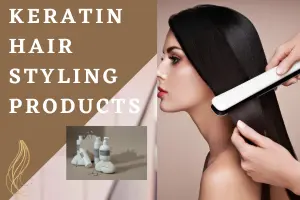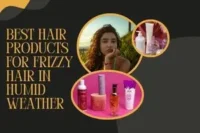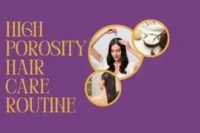The Best Hair Brushes for every Hair Type-The Most Comprehensive Guide
Published: 27 Nov 2024
Your hairbrush isn’t just a tool; it’s a total game-changer. It does more than just untangle your strands. The best hair brushes support healthy hair growth, boost shine, prevent breakage, and make styling easier. Whether you have curls, coils, fine strands, or thick hair, finding the perfect brush can completely transform the look and feel of your hair.
Using the wrong brush can cause damage like split ends, frizz, or even hair loss. But the right one? It brings your hair’s natural glow to life, making your routine smoother, healthier, and more enjoyable.
Brushing Wet Hair the Right Way
Brushing wet hair gently with a wide-tooth comb helps prevent breakage and reduces split ends. Always start from the tips and work your way up to avoid tugging and damage.
Why Wet Hair Needs Special Care
Wet hair is fragile; treat it like silk. After a shower, your hair holds moisture but becomes weaker and more prone to breakage. I made the mistake of dragging a comb through wet strands and ended up with more split ends. Now I use a wide-tooth comb or a detangling brush specifically made for wet hair. I start at the ends and work my way up gently.
Safe Brushing Technique for Wet Hair
When your hair is soaked, it gets heavier and places pressure on the roots. Experts like Michaeline Becker stress the importance of brushing gently, section by section, from the ends upward. In any Hair Detangling Guide, you’ll find that using a soft detangling brush or a wide-tooth comb is essential. Brushing from underneath instead of on top helps avoid tugging and breakage.
Best Hair Brushes by Hair Type & Purpose
Choosing the right hair brush can make a significant difference in your hair’s health and styling results. Below is a helpful visual to guide you through different types of brushes designed for specific hair types and purposes.
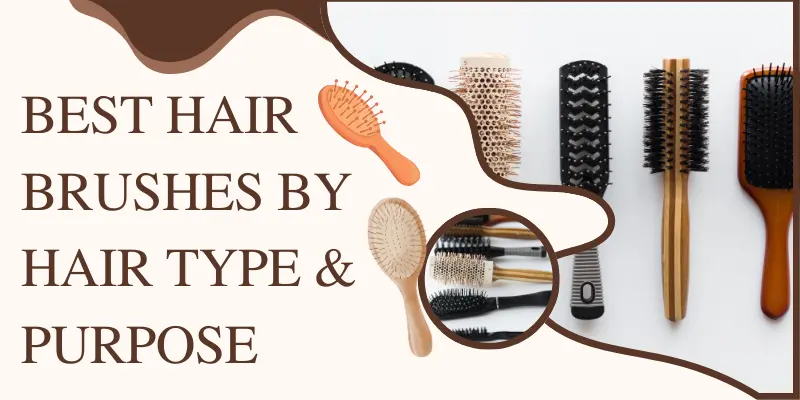
Now that you’ve seen the visual comparison, let’s break down each brush type in more detail. From detangling to volumizing, every brush has a unique role to play.
Paddle Brush
- Best for: Straight, fine, or medium hair
- Why: Great for smoothing and detangling. Helps spread natural oils from root to tip for a glossy finish.
Round Brush
- Best for: Fine or medium hair needing volume
- Why: Ideal for blowouts and adding bounce and curl.
Vented Brush
- Best for: Thick, wavy, or straight hair
- Why: Allows air to pass through for faster drying. Adds lift and reduces frizz.
Boar Bristle Brush
- Best for: Fine, weak, or damaged hair, especially when following Damaged Hair Care Tips to restore strength and resilience.
- Why: Distributes natural oils evenly. Gentle on strands and great for daily use.
Detangling Brush
- Best for: Curly, coily, or textured hair
- Why: Flexible bristles glide through knots. Helps preserve curl pattern and prevents breakage.
Teasing Brush
Why: Adds volume at the roots and creates structure for updos.
Best for: Fine or limp hair
Tips for Choosing the Right Hair Brush
Choosing the right hair brush depends on your hair texture, length, and styling needs. The image below highlights key tips to help you make the best choice for different types of hair.
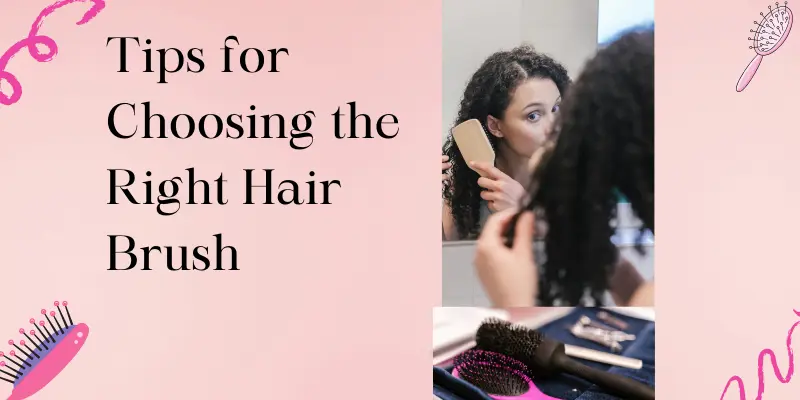
With these tips in mind, you’ll be better equipped to select a hair brush that enhances your routine and promotes healthier strands. Let’s explore each tip in more detail.
Know Your Hair Texture
- Fine Hair: Use soft, natural bristles.
- Thick Hair: Go for firm or synthetic bristles.
Define Your Styling Goals
- Sleek styles: Paddle brush
- Volume and curls: Round brush
- Quick drying: Vented brush
Understand Brush Materials
- Natural Bristles: Boost shine and are gentle.
- Synthetic Bristles: Durable and effective for detangling.
The Magic Behind a Hair Brush
A hair brush is more than just a styling tool—it plays a vital role in hair health, texture, and appearance. The image below reveals the hidden benefits that make Hair Brushes so essential in your daily routine.
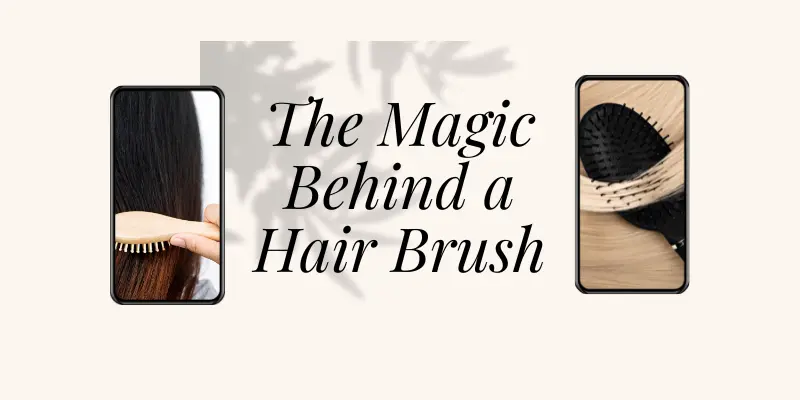
Understanding how a hairbrush works helps you get the most out of your brushing routine. Let’s take a closer look at the magic it brings to your hair care journey.
Why Brushing Feels Like Self-Care
Brushing is more than grooming; it’s a wellness ritual. Every stroke moves natural oils down the hair shaft, keeping strands soft and strong. I treat brushing like a mini scalp massage. It relaxes me and leaves my hair feeling hydrated and smooth.
Brushing Frequency Matters
I used to think brushing more was better. It turns out that brushing once or twice a day is enough. Experts recommend brushing your teeth in the morning and before bed to improve circulation and promote growth. I now brush slowly, making it part of my self-care, not just my routine.
Smart Detangling for Every Hair Type
Detangling doesn’t have to hurt. A good brush and gentle technique make it easy. Whether you have curls, coils, or straight hair, take your time. I’ve used brushes ranging from $7 to $29. Affordable ones can be just as effective.
From salon floors to backstage shows, I’ve learned that soft, patient strokes protect your hair and your budget. Look for flexible bristles, cushioned backs, and ergonomic handles.
Personal Experiences
When I went natural, breakage was my biggest problem. My brush wasn’t made for curls. Switching to a detangling brush with flexible bristles saved my hair. My curls became defined, and I spent less time detangling.
My friend with fine hair always struggled with volume. She switched to a boar bristle brush. Her hair stayed sleek without going flat. Now it’s her favorite styling tool.
I thought all brushes were the same until I saw my hair thinning. Harsh brushing was the problem. The cuticle, made of overlapping layers, was getting damaged. That led to dryness and frizz.
Turns out, it wasn’t just the brush. My routine included heat styling, stress, and rough towel drying. I had to reset. I switched to a wide-tooth comb, used ceramic tools, and started trimming my hair regularly. Adding vitamins and eating more greens also helped.
Even little things like hot water, tight elastics, and skipping conditioner made a difference. Brushing smarter, with care, helped me reverse the damage.
What’s Behind a Brush Full of Hair?
Every time I brushed, more hair stayed in the bristles. At first, I blamed the brush. But poor diet, over-processing, and stress were the real causes. A lack of protein, zinc, and iron affects hair growth.
I began eating plant-based meals, added supplements, and used leave-in conditioner. Managing stress and getting better sleep made a real change. I learned to use softer brushes and better tools, and my hair started to grow healthier.
Conclusion
Your hairbrush is more than a tool; it’s a key part of your hair care routine. By knowing your hair type and styling needs, you can choose from the best hair brushes designed for your unique hair. From detangling coils to smoothing sleek strands, there’s a perfect brush waiting to make your hair routine easier and healthier.
Don’t settle. Choose smarter, and your hair will thank you.
Frequently Asked Questions
It’s not ideal to use the same brush for both wet and dry hair. Wet hair is much more fragile and prone to stretching or breaking under tension. A detangling brush or wide-tooth comb is best for wet hair since it glides through knots without pulling too hard. Save your regular paddle or boar bristle brush for when your hair is completely dry to avoid unnecessary damage.
Hair brushes collect dirt, oils, and product buildup over time, so weekly cleaning is recommended. To clean, remove any trapped hair, then soak the brush in warm water mixed with a bit of shampoo. Scrub gently with an old toothbrush if needed, rinse thoroughly, and let it air dry completely. A clean brush ensures healthier hair and better styling results.
High-end brushes often use quality materials like boar bristles, cushioned bases, or ergonomic handles that provide comfort and durability. They can also distribute oils better and reduce static. However, you don’t need to spend a fortune—affordable brushes can work just as effectively if chosen for your hair type. It’s more about the right brush for your needs than the price tag.
Yes, using the wrong brush can lead to serious damage over time. For example, brushing wet hair with a stiff-bristle brush can cause breakage and split ends. Similarly, using too much force on tangled hair can rip strands from the scalp. The right brush minimizes pulling, reduces frizz, and keeps your hair healthier and shinier in the long run.
Children with sensitive scalps need gentle tools to avoid discomfort. A soft-bristle brush or a flexible detangling brush is ideal, as it reduces tugging and pain. These brushes glide through knots more smoothly and make hair care a calmer experience. Pairing brushing with a leave-in conditioner or detangling spray can also help ease the process.
Brushing curly hair daily is not recommended, as it can disrupt curl patterns and cause frizz. Instead, brush only when needed—preferably while the hair is wet and coated with conditioner. This ensures that curls stay defined while preventing tangles and breakage. For maintenance between washes, finger-combing or using a wide-tooth comb works best.
The type of brush and technique you use can make a big difference in adding volume. A round brush, used while blow-drying, can lift the roots and create bounce. A teasing brush or fine-tooth comb can also be used at the crown for extra height. Always work in sections and avoid over-teasing, which can weaken strands.
Yes, sharing brushes is not a good idea. It can spread oils, dirt, and product buildup, but more importantly, it can transfer scalp conditions such as dandruff, lice, or fungal infections. To maintain hygiene and hair health, everyone should use their brush. If sharing is unavoidable, disinfect the brush thoroughly before and after use.
For frizzy hair, a boar bristle brush is an excellent option because it distributes natural oils from the scalp down the strands, creating a smoother finish. A vented brush can also help when blow-drying, as it reduces drying time and controls frizz. The key is to use brushes that glide smoothly and don’t roughen the cuticle.
Yes, brushes can be useful for evenly spreading products like leave-in conditioners, oils, or serums. Detangling brushes, in particular, help distribute the product from roots to ends while reducing knots. This ensures every strand gets coated without overloading certain areas. It’s a great way to maximize product benefits while keeping hair smooth and manageable.

- Be Respectful
- Stay Relevant
- Stay Positive
- True Feedback
- Encourage Discussion
- Avoid Spamming
- No Fake News
- Don't Copy-Paste
- No Personal Attacks



- Be Respectful
- Stay Relevant
- Stay Positive
- True Feedback
- Encourage Discussion
- Avoid Spamming
- No Fake News
- Don't Copy-Paste
- No Personal Attacks

